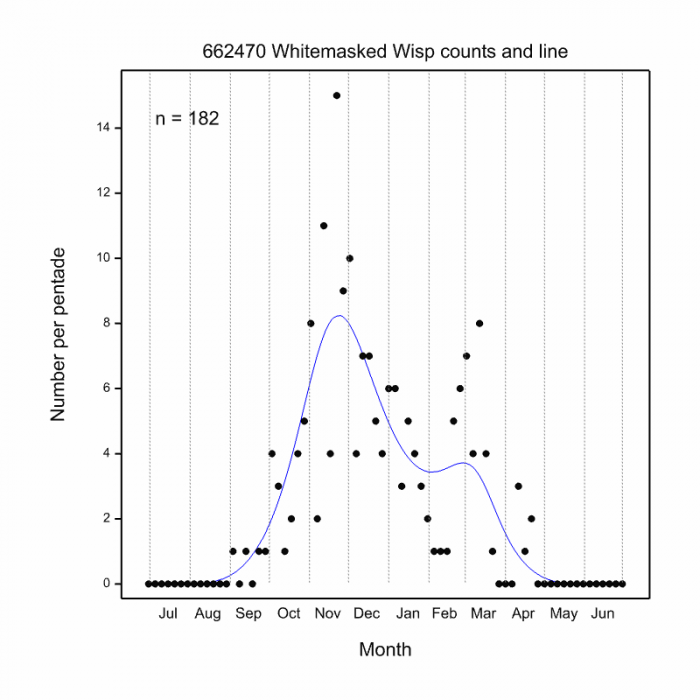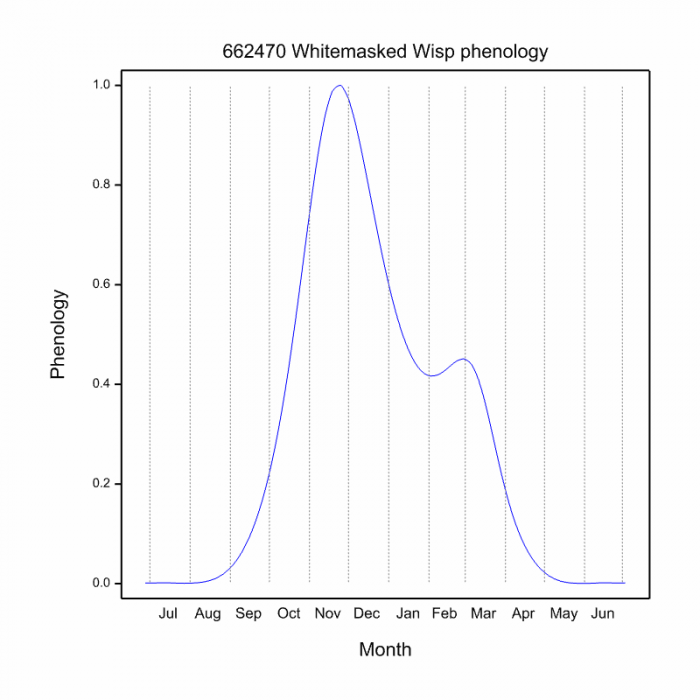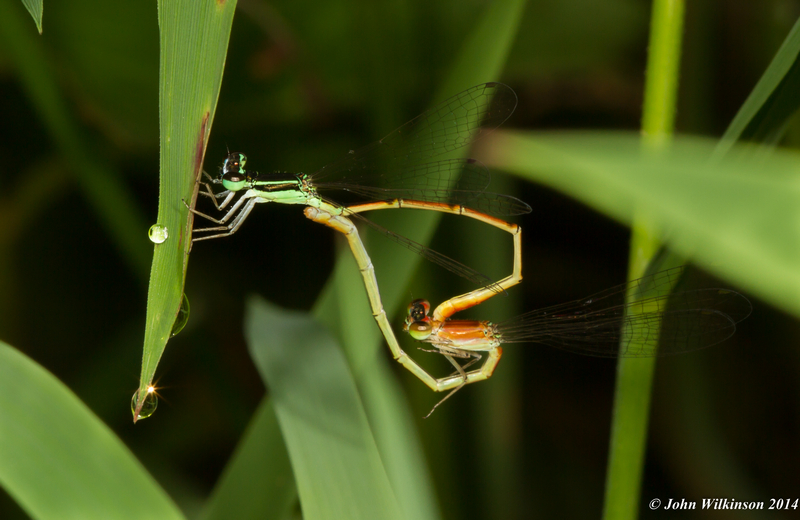View the above photo record (by John Wilkinson) in OdonataMAP here.
Find the White-masked Wisp in the FBIS database (Freshwater Biodiversity Information System) here.
Family Coenagrionidae
Agriocnemis falcifera – WHITE-MASKED WISP
Identification
Very small size
Length up to 25mm; Wingspan attains 30mm.
There are two subspecies, Agriocnemis falcifera falcifera and Agriocnemis falcifera transvaalica
When immature they are initially all orange-red, with later stages orange-red on the terminal segments of the abdomen only; when mature, only the terminal segments are orange-red. In old males the green colouration on the thorax and head turns pruinose white.
The forehead has a whitish band or ‘mask’ that runs from eye to eye and this is a diagnostic feature. The shape of the small green post-ocular spots are also diagnostic. They are tapered along the inner edge and connected across the back of the head in subspecies falcifera. In subspecies transvaalica the postocular spots are not connected.
Females are highly variable and range from all red or orange to green and black.
Most similar to Agriocnemis gratiosa (Gracious Wisp). The White-masked Wisp can be told apart by its tapered and joined postocular spots and the white moustache stripe in the males. These two species are the largest Southern African wisps which helps to separate them from the other smaller species.
Click here for more details on identification.
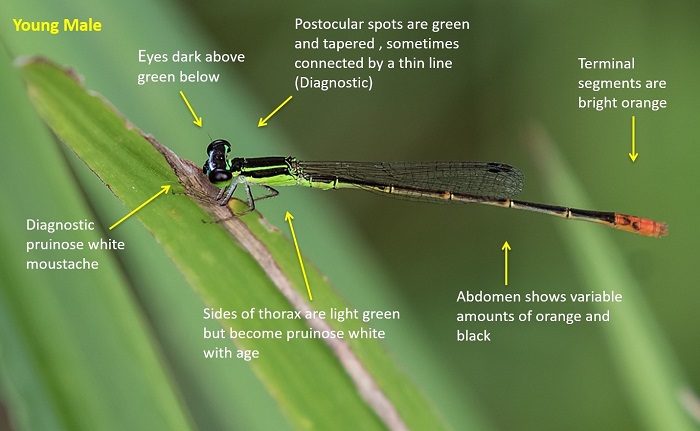
Kromme River, Eastern Cape
Photo by Gregg Darling
Habitat
This tiny damselfly is found along the fringes of ponds, lakes, pools and dams. Favours marshy sites with thick stands of grasses, sedge and reeds. Can on occasion be found along suitable, slow moving sections of rivers

Photo by Andries De Vries
Behaviour
Inconspicuous due to its tiny size and its habit of sitting low down among the grass stems, where it remains well hidden. Often gregarious.
On the wing from September to April. See Phenology below.
Status and Conservation
Locally common and endemic to South Africa. Listed as of Least Concern in the IUCN Red List of Threatened Species.
Distribution
It is endemic to south Africa. The subspecies Agriocnemis falcifera falcifera occurs in a broad strip along the east coast from northern KwaZulu-Natal to the Western Cape. Agriocnemis falcifera transvaalica occurs inland in parts of Mpumalanga, Gauteng and Limpopo.
Below is a map showing the distribution of records for White-masked Wisp in the OdonataMAP database as at February 2020.
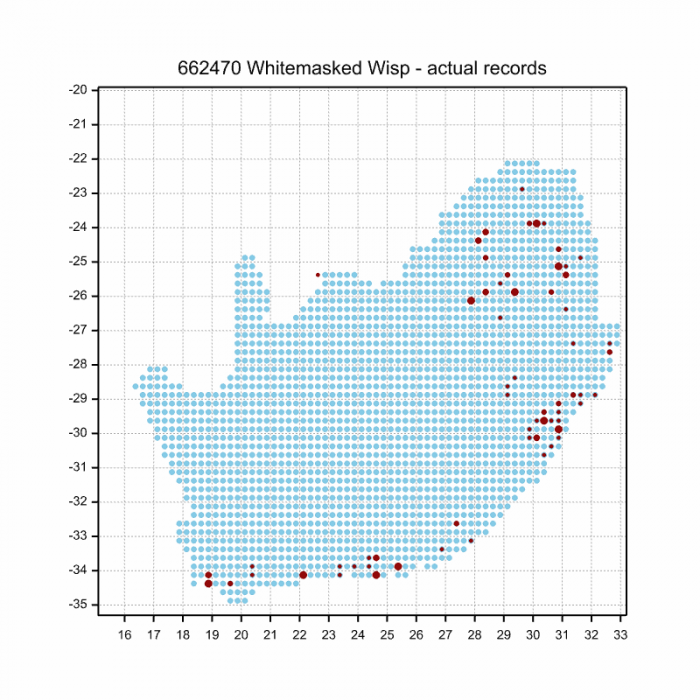
The next map below is an imputed map, produced by an interpolation algorithm, which attempts to generate a full distribution map from the partial information in the map above. This map will be improved by the submission of records to the OdonataMAP section of the Virtual Museum.


Ultimately, we will produce a series of maps for all the odonata species in the region. The current algorithm is a new algorithm. The objective is mainly to produce “smoothed” maps that could go into a field guide for odonata. This basic version of the algorithm (as mapped above) does not make use of “explanatory variables” (e.g. altitude, terrain roughness, presence of freshwater — we will be producing maps that take these variables into account soon). Currently, it only makes use of the OdonataMAP records for the species being mapped, as well as all the other records of all other species. The basic maps are “optimistic” and will generally show ranges to be larger than what they probably are.
These maps use the data in the OdonataMAP section of the Virtual Museum, and also the database assembled by the previous JRS funded project, which was led by Professor Michael Samways and Dr KD Dijkstra.
Phenology
